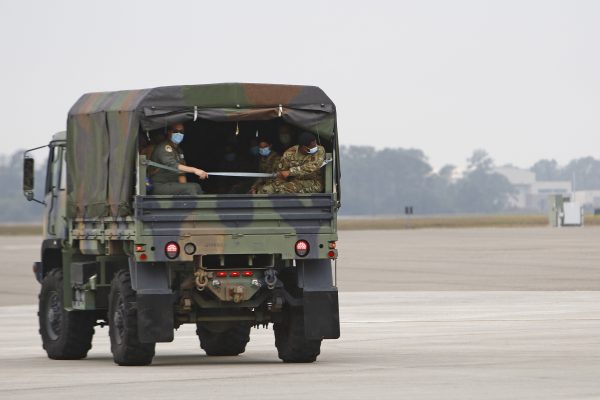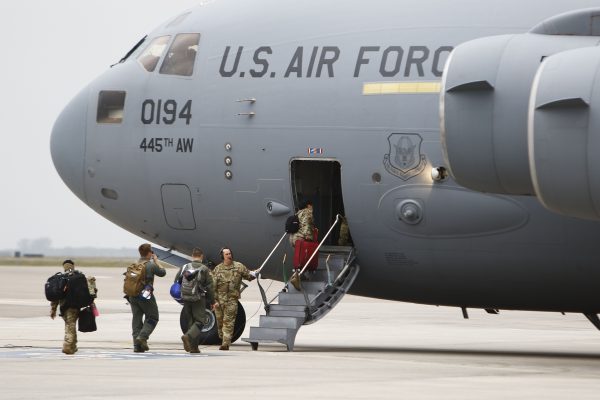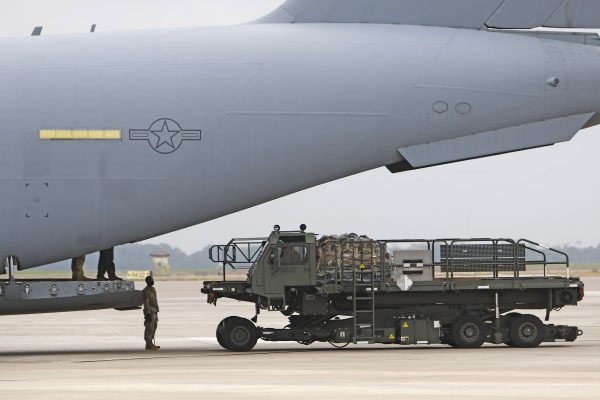Col. Jennifer Ratcliff, an orthopedic surgeon in Orlando, got the call April 4 at noon. Her commander was looking for reserve airmen to volunteer their medical expertise to treat COVID-19 patients in New York City.
At 10:30 a.m. the next day, Ratcliff and five other doctors and nurses assigned to the 927th Air Refueling Wing, a reserve unit based at MacDill Air Force Base in Tampa deployed into what has become an unprecedented military mobilization effort to combat the spread of the coronavirus.

Air Force Reserve airmen of the 927th Air Refueling Wing Aeromedical Evacuation Squadron load up at MacDill Air Force Base to join in the global Air Force Reserve Command mission to transport and treat COVID-19 patients around the world. Doctors and nurses of the 927th reserve wing will fly to a staging area in South Carolina where they will join others to be deployed to cities in need of assistance. A C-17 aircraft picked up the crew and their gear on Wednesday in Tampa.
(Luis Santana/Times/TNS)
“This is a different kind of attack on our country,” Ratcliff said.
Hundreds of reservists have mobilized in the past few days as the Air Force Reserve Command seeks to assist government leaders in the transport and treatment of COVID-19 patients across the country and around the world.
On Wednesday, about a dozen members of the 45th Aeromedical Evacuation Squadron based at MacDill deployed for their own COVID-19 mission to Joint Base Charleston in South Carolina. From there, they will depart to provide in-flight patient care across the globe where needed. Among them was Capt. Jake Silvola-Finch.
Silvola-Finch, a flight nurse and nurse manager at Tampa General Hospital, said that he and his team didn’t have all the mission details before the deployment. They simply were told to be ready within three days to go somewhere, at some time, to join the front lines.

Air Force Reserve Citizen Airmen of the 927th Air Refueling Wing Aeromedical Evacuation Squadron loads up at MacDill Air Force Base to join in the global Air Force Reserve Command mission to transport and treat COVID-19 patients around the world. Doctors and nurses of the 927th reserve wing will fly to a staging area in South Carolina where they will join others to then be deployed to cities in need of assistance. A C-17 aircraft picked up the crew and their gear on Wednesday, April 15, 2020 in Tampa.
(Luis Santana/Times/TNS)
“We’re learning on the fly how to protect ourselves and our patients,” he said.
But working at Tampa General these past few weeks, he has seen how leaders have had to adapt their care plans as the virus continues its spread. This, coupled with his military training, has left Silvola-Finch feeling prepared for the unique challenge that lies ahead.
Adaptability in uncertain circumstances is part of military training, and it has helped to ensure that these deployments run smoothly, said Col. Doug Stouffer, commander of the 927th Air Refueling Wing. Reservists typically get at least 72 hours to plan a mission; this first group got less than 24.
It’s all been shifting day by day.
Ratcliff, commander of the 927th Aerospace Medicine Squadron, said that soon after she and her team landed at Joint Base McGuire-Lakehurst in New Jersey, they were off to the Jacob K. Javits Convention Center in Manhattan, where the Army Corps of Engineers had created a temporary hospital. But soon they were off again, this time working inside civilian hospitals in the Bronx.

Air Force Reserve Citizen Airmen of the 927th Air Refueling Wing Aeromedical Evacuation Squadron loads up at MacDill Air Force Base to join in the global Air Force Reserve Command mission to transport and treat COVID-19 patients around the world. Doctors and nurses of the 927th reserve wing will fly to a staging area in South Carolina where they will join others to then be deployed to cities in need of assistance. A C-17 aircraft picked up the crew and their gear on Wednesday, April 15, 2020 in Tampa.
(Luis Santana/Times/TNS)
Their goal is to provide more manpower to overwhelmed New York City hospitals.
Ratcliff met with hospital unit leaders to learn how she and her team could help. She has had military training to deal with trauma, she said, but she’s never seen anything like this.
The empty streets and sidewalks of New York City made the landscape unrecognizable. But they also gave her hope that New Yorkers are staying indoors, and she knows that such efforts can help stop the spread.
While several unknowns remain, Ratcliff expects that full recovery as a nation will take a long time.
“It’s not going to be one day where people are not going to be sick anymore,” she said.
___
© 2020 the Tampa Bay Times
Distributed by Tribune Content Agency, LLC.



